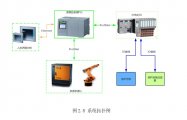自动加渣机器人的应用研究与设计

自动加渣机器人的应用研究与设计(任务书,开题报告,外文翻译,论文12000字,CAD电气原理图)
摘要
伴随着国内钢铁工业的起步和升级,无缝连铸技术的重要性不断被提高。随之而来的,是对保护渣加入技术的要求愈发严苛。显而易见的,人工加渣已然无法满足工业生产的需求。因此,自动加渣机器人的出现就显得非常及时。自动加渣技术对于生产者的保护和对于加渣量的精确控制都让手动加渣难以企及。
库卡机器人公司经过多年的发展已然成为国际知名的机器人公司。在自动加渣方面,库卡机器人的运用非常广泛,因此我们在本次设计中选用库卡机器人系统作为实验平台。
在控制主体上,根据设计要求选用西门子S7-1500系列中的CPU1516-3 PN进行与机器人的信息交互。并在此基础上完成整体设计。最终完成程序编辑和仿真。
关键词:自动加渣技术;库克工业机器人;S7-1500PLC
Abstract
With the start and upgrading of domestic iron and steel industry, the importance of seamless continuous casting technology has been continuously improved. Accompanied by this, the requirement of powder addition technology becomes more and more stringent. Obviously, manual slagging has been unable to meet the needs of industrial production. Therefore, the emergence of automatic slagging robot is very timely. Automatic slagging technology for the protection of producers and the accurate control of slag dosage make manual slagging difficult to achieve. [来源:http://Doc163.com]
After years of development, Kuka Robot Company has become an internationally renowned robot company. In the aspect of automatic slag filling, the Kuka robot is widely used, so we choose the Kuka robot system as the experimental platform in this design.
On the control body, according to the design requirements, the CPU1516-3 PN of Siemens S7-1500 series is selected to interact with the robot information. On this basis, complete the overall design. Finally, program editing and simulation are completed.
Key Words:Automatic Slag Adding Technology; Cook Industrial Robot; S7-1500 PLC
[来源:http://Doc163.com]





[资料来源:https://www.doc163.com]
目录
第1章 绪论 1
1.1 课题背景及意义 1
1.2 研究目的和主体思路 2
1.2.1研究目的 2
1.2.2主体思路 3
1.3自动加渣机器人研究现状和发展趋势 3
1.4本文主要内容 5
第 2 章 设计方案和思路 6
2.1设计方案 6
2.2 KUKA工业机器人简介 6
2.3 KUKA机器人运动原理和基本参数 8
2.4 K8人机界面介绍 11
2.5 ProfiNet总线通讯简介 12
2.6 西门子S7-1500系统简介 13
2.7硬件选型 14
2.7.1西门子CPU1516-3 PN简介 15
2.7.2 KUKA机器人KR30-3 F简介 15
第3章 程序设计 17
3.1系统拓扑图 16
3.2系统流程图 17
3.3西门子PLC ProfiNet总线配置 19 [资料来源:www.doc163.com]
3.4机器人端配置ProfiNet 19
3.5机器人端IO配对 20
3.6配置机器人外部自动信号 21
3.7机器人外部自动程序 22
第4章 结论与展望 24
4.1 心得体会与结论 24
4.2 我的展望 26
参考文献 27
附录 28
致 谢 33
[资料来源:Doc163.com]
